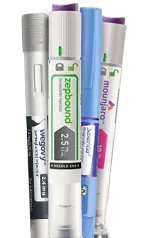Is Cycling Good for Weight Loss? What You Need to Know
Embarking on a weight loss journey often involves increasing your physical activity.
However, finding an effective weight loss exercise that fits your busy lifestyle can be challenging. This is where cycling comes in.
Not only is cycling an excellent form of low-impact cardio, but it’s also known for burning hundreds of calories and enhancing your weight loss results.
In this article, we’ll discuss what you need to know about cycling for weight loss, including tips on choosing the right bike and how you can maximize fat loss to help you achieve your goals.
Get prescription weight loss medication online.
Find out if you're eligible for GLP-1s, and get started on your weight loss journey for as low as $75/month.


Why is Cycling a Good Form of Exercise?
Cycling can be a great form of low-impact cardio and aerobic exercise with various other health benefits. These include:
Low impact on your joints compared to more strenuous forms of cardio — like running or aerobics — which makes it a great choice for older adults or individuals who are prone to injuries
Can be done outdoors on a traditional bike, or indoors — at home or at the gym — using a stationary bike
Accessible for both beginners and seasoned athletes
Can improve heart health and promote better blood circulation, which helps reduce your risk of cardiovascular disease
Involves the major muscle groups — such as the quadriceps, hamstrings, and calves — which can help burn fat, build strength, and improve endurance
Improves core and back strength, contributing to your overall stability
Mental health advantages, including reducing symptoms of stress, anxiety, and depression
Can help you lose belly fat and shed excess pounds to achieve a slimmer appearance
These benefits can go a long way in helping you achieve your health and fitness goals, especially if you’re unable to do other forms of cardio.
The Benefits of Cycling for Weight Loss
Burns significant calories
One of the most immediate benefits of cycling is its ability to help you burn a large amount of calories.
Depending on the intensity of the ride and your weight, cycling can burn anywhere from 400 to 1,000 calories per hour.
A higher-intensity session also increases the amount of calories you burn. For example, mountain biking or cycling uphill will burn more calories compared to a leisurely ride.
This makes cycling an excellent option for individuals who need to create a calorie deficit — which is when you burn more calories than you consume — to promote weight loss.
Increased metabolic rate
Regular bike rides can help you increase your metabolic rate, which is the amount of calories you burn at rest.
An increased metabolic rate means that your body continues to burn calories at a higher rate, even when you’re not exercising.
This is primarily because cycling increases muscle mass, which requires more energy to maintain than fat tissue.
As you develop more muscle and improve your fitness, your body burns more calories more regularly and you start to lose weight quicker.
Can help trim fat
Cycling can help you target body fat, making it a great workout option for individuals who want to achieve a leaner body composition.
Engaging in steady, moderate cycling can help the body shift into a state of burning fat for energy, which can help reduce body fat over time.
You can also engage in high-intensity interval training (HIIT) on a bike — such as during a spin class — which can help you lose fat more effectively.
Key Point: What’s the Difference Between Burning Calories and Burning Fat?
There is a key difference between burning calories and burning fat.
Burning calories refers to using energy for physical activities from the calories in the food you consume.
Burning fat refers to using stored fat in the body as an energy source rather than food. This happens when the body requires more energy than what is available from the food you eat.
How to Start Cycling for Weight Loss
Choosing the right bike
The first step to starting cycling is to choose the right type of bike for your needs.
For example, if you’re planning to cycle on roads or paved paths, a road bike is typically your best option. For rougher terrain, a mountain bike would be more appropriate. Mountain bikes can also be used on the road.
You could also choose a hybrid bike — which combines features of road and mountain bikes — to ensure versatility.
A hybrid bike is a better choice for beginners who may not yet know which type of cycling surface they prefer.
Creating a good routine
Once you have your bike, it’s time to create a sustainable cycling routine that will help you reach your fitness goals.
Try to start with shorter, more frequent rides as you build up your fitness and endurance.
Aim for at least 30 minutes of cycling three to four times per week. Don’t worry too much about distance when you start; you can increase your mileage as your stamina improves.
Alternate between indoor and outdoor cycling. As a beginner, it may be best to start with indoor cycling before heading outdoors to build your confidence.
In addition to your cycling routine, it might also be a good idea to incorporate cross-training — which is combining different types of exercise — to maximize fat loss.
You can include a few days of high-intensity interval training (HIIT) or other strength workouts to improve your endurance. Swimming or pilates are also great options.
This adds variety to your workout routine, which can prevent boredom.
Remember that consistency is key for weight loss, so try to stick to your planned schedule as far as possible.
Tracking your progress
To ensure you stay motivated and reach your goals, track your progress. There are a few ways you can do this:
Use technology: Use fitness apps — like Strava — to help track your distance, speed, and the amount of calories burned per ride. These tools also provide valuable feedback to help measure your progress.
Set achievable goals: Establish realistic, measurable goals — such as weekly distance, weight loss targets, or consistency. Having specific aims can help you stay focused and motivated.
Keep a journal: Maintain a cycling journal to record your rides, how you feel, and your progress toward your weight loss goals. Reflecting on your journey can help you adjust your goals and strategies as needed.
Ready to achieve your weight loss goals?
Shed pounds with GLP-1 medication prescribed online by licensed healthcare providers for as low as $75/month.


Enhancing Your Weight Loss Efforts while Cycling
Dietary considerations
To lose weight while cycling, you’ll need to fuel your body properly by following a balanced diet. This includes consuming foods like:
Fruits and vegetables
Lean proteins, like chicken breast or turkey meat
Whole grains, like quinoa and brown rice
Avoid high-calorie foods — such as takeout, processed meats, and candies — and opt for nutrient-dense, filling meals to keep you energized for longer rides.
It’s also essential to stay hydrated during long rides to help regulate your body temperature and ensure nutrient absorption.
This boosts your metabolism, helping you burn more calories.
Joining a cycling community
Joining a cycling group can help provide encouragement and variation in your exercise routine, which can improve your consistency.
Group rides can motivate you to cycle longer and faster than you might on your own.
Many cycling communities offer structured rides and events, which can add a goal-oriented element to your cycling routine.
This can help motivate you to train regularly to improve your endurance and speed.
You can also try out spinning classes at your local gym to keep your cycling routine interesting and socialize with other bike enthusiasts.
Should You See a Doctor Before Beginning to Cycle for Weight Loss?
When using cycling to help you on your weight loss journey, it’s important to consult your doctor beforehand. This allows them to:
Assess your overall health — including checking for signs of heart disease, high blood pressure, or diabetes — to determine if cycling is appropriate for you
Evaluate your overall fitness level to recommend a suitable cycling routine to minimize injuries and burnout
Provide personalized advice on weight loss, including additional steps you can take to achieve a healthy weight and other fitness goals
Monitor your progress, especially if you have significant weight loss goals
Consulting your doctor during your fitness journey can be a great way to get professional support and ensure you’re losing weight safely.
They can also spot any issues early on and recommend adjustments to your workout routine, helping you avoid any complications.
Where Can You Learn More about Achieving Your Weight Loss Goals?
While LifeMD can’t offer cycling advice, we can perform a virtual health check and assist you in managing any underlying conditions or answer questions about your cardiovascular well-being.
A team of medical professionals can help you with lab orders, medications, and prescriptions, if necessary.
You may also qualify for the LifeMD Weight Management Program, where a team of clinicians can help you achieve your health and fitness goals.
More articles like this
Feel better with LifeMD.
Your doctor is online and ready to see you.
Join LifeMD for seamless, personalized care — combining expert medical guidance, convenient prescriptions, and 24/7 virtual access to urgent and primary care.

GLP-1
Zepbound® Wegovy® Saxenda®
This is it! Be part of the weight loss movement everyone’s talking about.
Get Started Now
 Medically reviewed and edited by
Medically reviewed and edited by 








